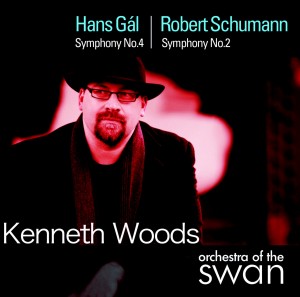A new review from musicologist extraordinaire, Calum MacDonald in the May 2012 issue of International Record Review. On newsstands now, or subscribe via the IRR website here.
Now, please go buy a copy so we can make volume 3.
Click here to order from Amazon.co.uk
Click here to order from Amazon.com
From International Record Review
May 2012 (pp 32-3)
I had nothing but praise for the previous disc from Kenneth Woods with the Orchestra of the Swan of Hans Gál’s Third Symphony coupled with Schumann’s ‘Rhenish’ (reviewed in July/August 2011). I find myself in a similar position now.
Gál composed his Fourth (and last) symphony in 1973 at the age of 83; like the other works of his advanced old age it is consciously a last visitation of its genre, but in no sense a work of farewell. Perhaps it’s better to think of it as what the Germans call a Bekenntniswerk (A work that declares a belief), instinct with a lifetime’s experience but still full of life. Gál subtitled it ‘Sinfonia concertante’ and it features a quartet of soloists- violin, cello, flute and clarinet—in addition to a severely Classical orchestra of paired oboes, bassoons and horns with timpani and strings. In his programme note for the 1975 premiere in Edinburgh (for which he had to extract all the performing materials himself), Gál likened the result to a concerto grosso, but though the soloists have a great deal to do both individually and as a group, I feel less of a Baroque antiphony between the four soloists’ concertino and the orchestra’s ripieno than a sense in which the soloists take part seamlessly in a constantly evolving symphonic argument, not so much displaying their virtuosity as bringing out the individual voices of Gál’s deft and intricate polyphony, into enhanced relief.
The work’s overall effect, like that of the Third Symphony, is conditioned by the rather paradoxical “serenade” character that informs much of Gál’s late music. The four movements comprise a preludial ‘Improvvisazione’ introducing an Allegro moderato, a ‘Scherzo leggiero’ that, according to the composer, is a ‘burlesque masquerade’ on the figures of Harlequin and Columbine from the commedia dell’arte, and an Adagio entitled ‘Duetto’ that spotlights the solo violin and cello, and a cheerful rondo finale entitled, as if to deflect any hint of seriousness, ‘Buffoneria’. The spirit of Busoni’s Junge Klassiztät (youthful classicality) seems to preside over the work, most of all in the Italianate leanings of scherzo and finale. The urbane and civilized surface, like a friendly, quizzical smile that never slips even if maintained in the face of long and wearisome experience of fate and human nature, does not exactly conceal great depths, but it certainly diverts the attention—at least on first hearing, so I recommend several repeated ones—from the symphony’s extraordinary richness of ideas and all-encompassing technical command. Equable but not comfortable, infused with a Haydn-like sanity, the work simply stands in principled opposition to chaos, opportunism and the vagaries of fashion. This doesn’t make it a masterpiece (its mastery does that). Throughout his career, Gál felt himself to be in the Brahmsian tradition, though his music seldom sounds particularly Brahmsian. Yet Brahms himself– usually so niggardly of praise for the efforts of the younger generation—would surely have found warm words of admiration for Gál’s Symphony no. 4.
Schumann’s C major Symphony, like the Rhenish on Woods’s previous Gál/Schumann coupling, receives a first-rate performance, perhaps a little hard-driven in places but with a wonderful sense of expansiveness and profound and delicate feeling in the slow movement. Gál, in his BBC Music Guide on the Schumann orchestral works, described this symphony as ‘not without problems’—but those problems can be compensated for by sufficiently intelligent pacing of the first movement and finale, which these movements certainly receive here. Though I wouldn’t place it, as an interpretation, quite on a par with those of Muti, Marriner or Solti (whom I find especially impressive in this work), it‘s a very fine one, and the playing of the Orchestra of the Swan is absolutely top-notch. I found its ‘Rhenish’ a little small-scale (and it is, when all’s said and done, a smallish orchestra) but there’s no hint of that here.
It remains to point out that David Le Page, Christopher Allan, Diane Clark and Sally Harrop—the concertante soloists in the Gál—play throughout with refinement, beautiful tone, an understanding of the idiom and complete understanding of their role in the composer’s polyphonic web. All in all, this is a very welcome and highly recommendable release.
Calum MacDonald

Recent Comments